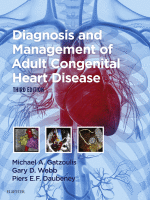Physical Address
304 North Cardinal St.
Dorchester Center, MA 02124

Anomalous coronary arteries are frequently seen in conjunction with certain other congenital cardiac defects and may even be considered inherent in some anomalies, such as in transposition of the great vessels. These abnormalities, which may be called secondary coronary artery…

Definitions The term heterotaxy comes from the Greek heteros, meaning “other” and taxis, meaning “arrangement.” The nomenclature and definition of heterotaxy have been a matter of debate for years and remain controversial. The complex combinations of cardiac malformations found in…

In hearts with a univentricular atrioventricular connection both atria are connected to a single ventricle; this includes hearts with either atrioventricular valve (AVV) atresia or a double-inlet atrioventricular connection. Either the tricuspid or mitral valve may be atretic in a…

Definition and Morphology The nomenclature for single ventricle has been a subject of debate for years. Double-inlet ventricle is commonly defined as the morphologic arrangement in which more than 50% of both atria are connected to one dominant ventricular chamber.…

Double-outlet right ventricle (DORV) is a “disease” that includes a family of anatomically related complex congenital heart lesions involving the right ventricular outflow tract (RVOT). There are several variations within the DORV diagnostic category that give rise to a wide…

Definition and Morphology Congenitally corrected transposition of the great arteries (CCTGA) was described in 1875 by von Rokitansky and is characterized by atrioventricular (AV) and ventriculo-arterial (VA) discordance. CCTGA may also be referred to as ventricular inversion or L-transposition of…

Definition and Morphology In 1897, Victor Eisenmenger, an Austrian physician, first described both the clinical and pathologic features of irreversible pulmonary vascular disease in a 32-year-old man with a nonrestrictive ventricular septal defect, cyanosis, and dyspnea since infancy. The patient…

Definition and Morphology The term transposition of the great arteries (TGA) describes the anatomic arrangement in which the aorta arises from the right ventricle (RV) and the pulmonary artery from the left ventricle (LV). This malformation was first described in…

Definition and Morphology Pulmonary atresia with intact ventricular septum (PAIVS) was first described by John Hunter in 1783. It is a rare congenital cardiac malformation with considerable morphologic heterogeneity, and until recently, relatively poor outcome. There is complete atresia of…

Definition and Morphology Absent pulmonary valve syndrome is a rare congenital cardiac malformation that was first described anatomically by Chevers in 1847. The first clinical case report was published in 1927, the typical anatomy described in a 58-year-old with chronic…